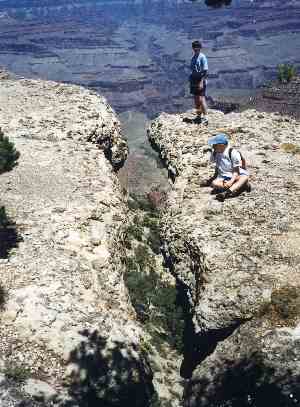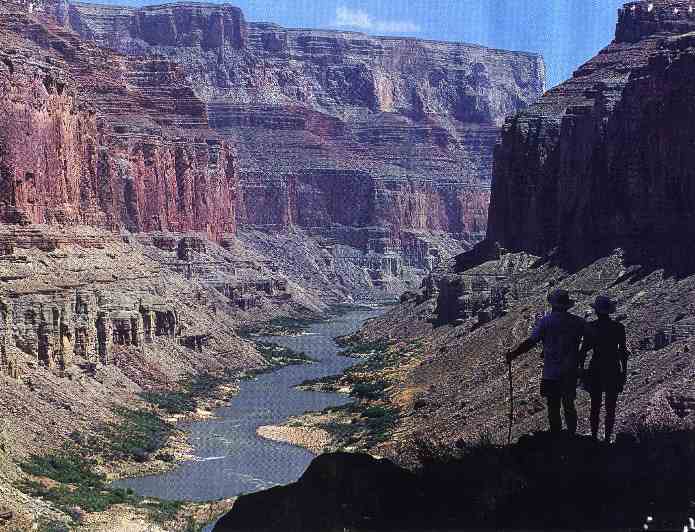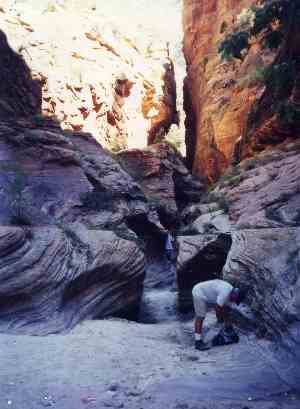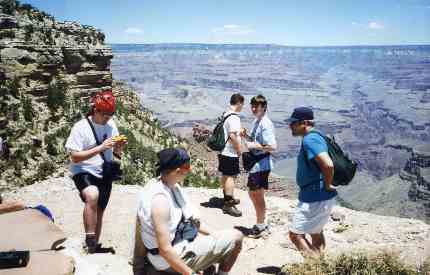

| Route 66 | Cities | Beaches |
Backpacking |
Mules |
Rafting |
Cameron |
Havasu |
Sky Walk |
North Rim |
 |
 |
| South Rim | West Rim | Boucher | Bright Angel | South Kaibab | Hermit | Grandview |
The Grand Canyon is one of the great hiking destinations in the world. The views are spectacular, the trailheads easily accessible, the country they descend into is varied and fascinating, and there is enough challenge to provide great satisfaction each time you complete a day's hiking. With nine trails just on the South Rim, you could stay here two weeks without hiking the same trail twice, or you could return for two or three shorter visits and never hike the same trail twice. You don't have to worry about mosquitoes, poison ivy, getting caught in the rain or getting lost. The place is so unique that regardless of where you're from, the plants, animals, birds, rocks and climate will be drastically different. The Back Country Office is very well staffed and managed so you can get any questions fully answered. The trails are well maintained. The Canyon is a photographer's fantasy to the point where you can't make good time hiking for stopping every few steps to snap pictures. Not only does the scenery change with every few steps, but it changes as the sun arcs across the sky, different light angles producing different shadows and colors on the rocks. In short, the Grand Canyon is a hiker's dream. |
 |
 |
However, it is a treacherous and demanding Paradise. You have to think through your plans carefully and there are certain precautions you MUST take. You cannot head below the rim the day you arrive. Everybody thinks of the Canyon as being "down," but first the Rim is quite far UP. You're at 7000 feet, higher than the tallest mountaintops back East. The air here is thin and the altitude affects the human body. You need at least 24, and probably 48, hours to adjust. One way to do this is to spend a day shopping, driving over to the Cameron Trading Post, stopping at the Watchtower, and perhaps watching the IMAX show. The second day can be spent hiking the South Rim Trail. Begin your hike at 9 a.m. from the South Kaibab Trailhead, and you should reach El Tovar sometime early afternoon. Stop for lunch in one of the restaurants or the Maswick Cafeteria. Then assess how tired and hot you are and what condition your feet are in. If you're still fresh, consider hiking the West Rim Trail during the afternoon and early evening. You can take the shuttle bus back from Hermit's Rest. A good dinner, perhaps a relaxing view of the sunset, a good night's sleep, and you'll be ready for below the rim hiking by the third day. We have watched hundreds of thousands of people come to the Grand Canyon and try to short cut this adjustment process, and half of them had to be rescued from below the rim when the heat, altitude and steep climb proved too much. |
Your next concerns need to be Sun. We recommend you apply the highest number sunBLOCK you can find. You're not here to work on your tan. Forget it. That sun in this high, thin, cloudless air is deadly. People burn to a crisp here. Thousands of people a year need medical attention for severe sunburn here and hundreds of them need hospitalized for at least one night. Many hikers assume that their tan protexts them from burn. No. The sun's rays here are so much brighter, and they reflect off the walls and the ground. The Grand Canyon is a giant microwave. Your skin has not been exposed to this before. Not only do you need to apply sunBLOCK, but you need to keep REapplying it. Back home, lots of people don't worry about the sun until around 10 or 11 am, and quit worrying about it around 3 or 4 pm. Not here. Between 8 and 6 you need sunBLOCK. You also need to apply a generous dose of chapstick to your lips and zinc to your nose and ears and keep REapplying it. You need a broad brimmed hat and a neckerchief. You're not trying to play John Wayne. You're trying to protect yourself. There was a reason cowboys wore hats and neckerchiefs. There's no reason to fear the sun here. You just need to take precautions. |
 |
 |
Your third concern needs to be Dehydration. If you're carrying one of those little belt weather meters, you'll notice there is almost zero humidity here. The dry air will suck the moisture from any surface. This includes you. You'll notice you don't really perspire here. Your sweat glands, of course, are working hard. But as soon as those drops of perspiration reach the air, they evaporate. So you don't realize how much water you're losing. People and even dogs faint here every day from dehydration. It's one reason so many hikers below the rim need to be rescued. To avoid this, you need to drink plenty of fluids at each meal for several days beforehand so you build a reservoir of water. The morning of your hike, drink as much as possible. Then carry at least TWO water bottles. They sell them at every shop and even the cafeterias at the Canyon, but theirs are small mouth single wall plastic and metal bottles. We recommend you buy large mouth double walled metal bottles back home before you come. There are water stations every mile along the South Rim Trail and three times between the Rim and Indian Gardens Campground on the Bright Angel Trail. Use them. |
Your Feet are your next concern. Along the Rim, you'll be hiking level terrain, but the trails are paved. This makes for smooth hiking, but it heats up in the bright sun and the heat transfers up to your feet. The pavement is also hard, not the soft cushioning dirt of forest trails. Below the Rim, you'll usually be either hiking steeply Down or steeply Up. The sand and rock also absorb and transfer heat. The trailbeds contain a lot of loose sand, gravel and rocks. So your feet will take more pounding, twisting, heat and pressure than they're used to. Even for day hiking, you need good boots, with leather uppers and strong arch and ankle supports. Pay attention to the scree collars. Many boots don't have them, or have poor ones. You need good ones here. Wear two socks, one thick and one thin "liner." Thoroughly rub talcum powder into the feet before you start, then put on the liner sock, rub more talc into it, and finally put the thick sock on and rub talc into it. Every hour, stop for a drink, take off your boots and change socks, retalcing the feet and each sock as you put them on. We highly endorse Moleskin. Carry a small pack with its scissors. If you develop a hot spot, cut a Moleskin pad tofit and put it on. Done in time, this will usually prevent a blister. |
 |
 |
The Heat at the Grand Canyon must be dealt with. Every day during the Summer months people need treatment for, and sometimes hikers need rescued from, Heat Prostration. Sometimes the line gets pretty thin between Dehydration and Heat Prostration, and one can lead to the other. But you and your hiking partners need to continually monitor yourself and each other. Every time you stop, do so in the shade. We highly endorse Neckerchiefs. Every time you pass a water source, soak the kerchief, then tie it back around your neck. As it evaporates, it creates a cooling effect. If you really have trouble with heat, buy one of the absorbent hats that you can soak in water and put on. Again, as it evaporates, it cools you. Headaches, nausea, dizziness, and leg cramps are warnings that you may be overheating. At the first indication of any of these, STOP at the first shady spot, drink and rest. One problem is people ignore symptoms because they don't want to slow the group. But if you collapse, you'll ruin the group's whole day. Much better to stop briefly and recover. |
Any day of hiking uses energy. But hiking here adds to that. Continually cooling your body in 100+ degree heat uses energy. Descending and then ascending steep trails uses energy. You have to have some way of replenishing this extra energy drain. One issue is oxygen. The air is thinner up here at 7000 ft., so you need more red blood cells. We recommend eating a pack of raisens and drinking a daily glass of red wine for two weeks before arriving. That will build your iron. Red blood cells require an Fe molecule at their center, so more iron means more red blood cells. This allows your blood to carry more oxygen, which produces the reaction which produces your energy. While here, we recommend a few bananas each day, for the Potassium. You can pick up bananas in the Maswick or Yavapai cafeterias. |
 |
 |
None of these dire warnings are meant to discourage anyone. On the contrary, we think everyone needs to hike the Canyon. It's a life altering experience. We just don't want people getting sunburned, dehydrated, exhausted, blistered or otherwise incapacitated. With all of this in mind, the list of trails is not a random buffet you can pick from in any order. They have a definite order, and you need to follow it. You should always begin with the South Rim and West Rim Trails just for acclimatization and orientation. It loosens your leg muscles after a long car trip or train ride. Then you should hike the Boucher Trail, still on top but off pavement. The first trip below the rim should be on Bright Angel Trail. It has the water huts plus the water and composting toilets at Indian Gardens. It is also closest to assistance if you get in trouble. The second trip below the rim should be on South Kaibab. It lacks the water supplies but is still meticulously maintained and has enough people on it and mule pack trains travellling up and down that if you get in trouble help is available. The third trip below the rim should be on Hermit. By now you should be developing some instincts for how far down you can go and still get back up, on how to pace yourself, how to manage your water, and how to deal with the heat, sun and trail conditions. These will be needed, because the Hermit Trail is not as well maintained as Bright Angel and South Kaibab, not as well travelled, and no longer has the mule pack trains. There are three major rock slides to traverse. So Hermit is considered the first of the Intermediate trails in the Canyon. After Hermit, your next trail should be the Grandview. From that trail on, you'll be ready for Tanner and New Hance. In addition to being steeper and rougher, those Advanced Trails are poorly marked so you have to be able to do a little orienteering. |
|
|||
|